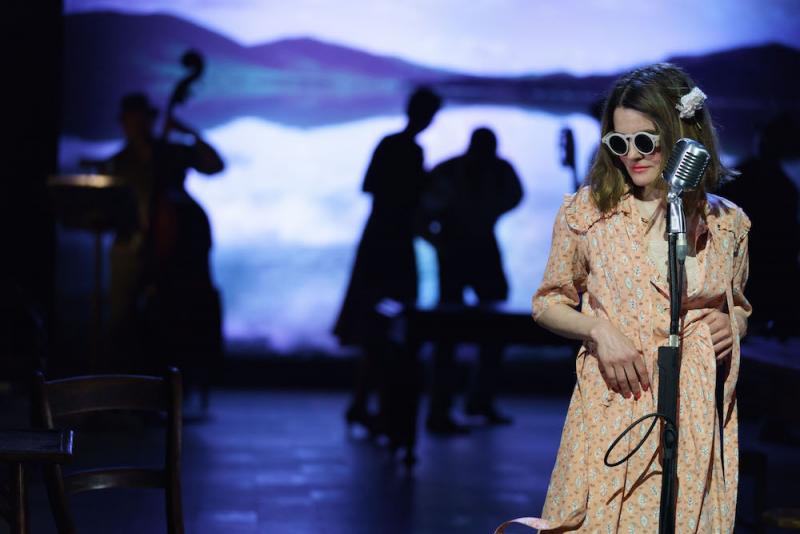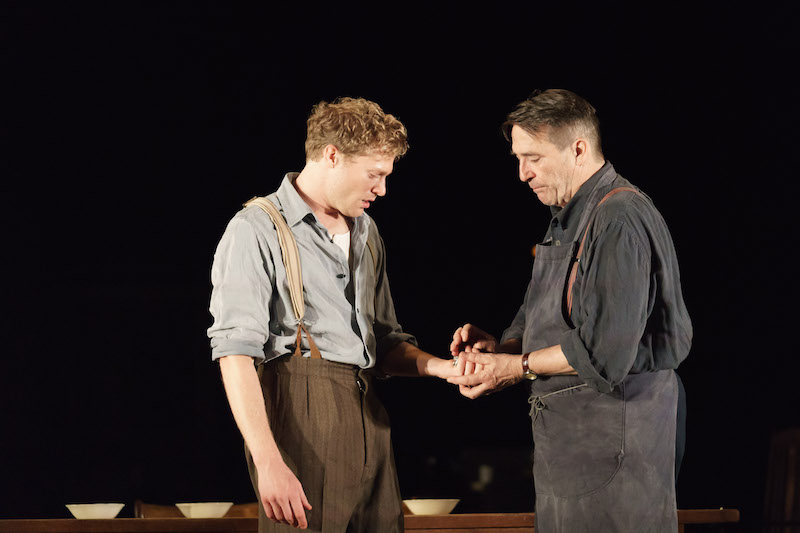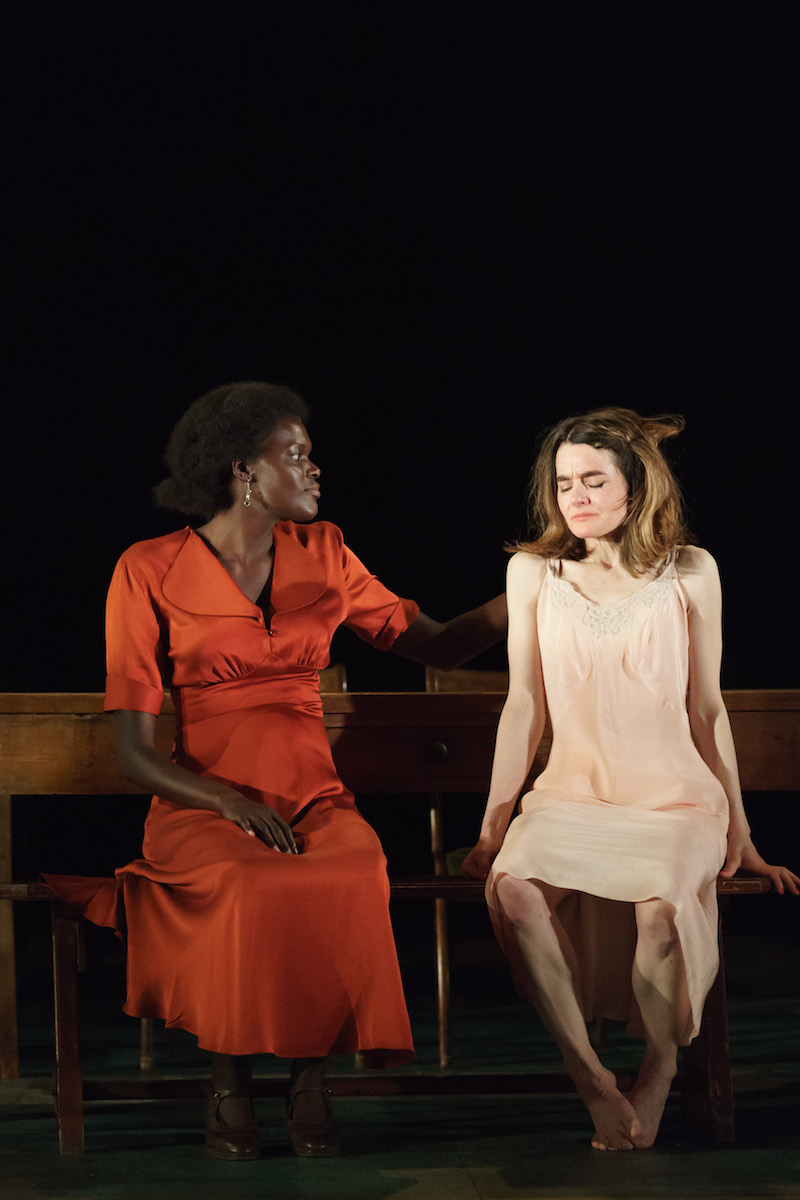Girl from the North Country, Noël Coward Theatre review - Bob Dylan fuels a dreamlike drama | reviews, news & interviews
Girl from the North Country, Noël Coward Theatre review - Bob Dylan fuels a dreamlike drama
Girl from the North Country, Noël Coward Theatre review - Bob Dylan fuels a dreamlike drama
Conor McPherson's latest play is blowin' in the wind

The rolling stone is now at home in the West End, as Conor McPherson’s inimitable dramatic take on Bob Dylan transfers from the Old Vic, where it premiered last summer.
Set in Dylan’s hometown of Duluth, Minnesota, in the Depression-era 1930s, writer/director McPherson gathers a desolate gaggle of folks in a rundown guesthouse: owner Nick Laine (Ciarán Hinds, pictured below with Sam Reid), struggling to stay afloat; wife Elizabeth (Shirley Henderson), suffering from dementia; their hard-drinking son Gene (Sam Reid) and mysteriously pregnant adopted daughter Marianne (Sheila Atim); plus numerous guests and neighbours – all running from creditors, the past, or an inevitable fate. The sheer size of the ensemble, and the use of almost mythic archetypes, renders the characterisation more of a breadth-not-depth affair. The boozy writer longing for escape (“Hemingway”, sniffs his father derisively) is instantly recognisable; this iteration doesn’t stray far from tradition. Nor does the devious bible salesman, wronged boxer, sidelined mistress, local doctor spouting Thornton Wilder-esque narration, or family with a deep, dark secret. Some revelations are explosive; others, infuriatingly, simply dissipate.
The sheer size of the ensemble, and the use of almost mythic archetypes, renders the characterisation more of a breadth-not-depth affair. The boozy writer longing for escape (“Hemingway”, sniffs his father derisively) is instantly recognisable; this iteration doesn’t stray far from tradition. Nor does the devious bible salesman, wronged boxer, sidelined mistress, local doctor spouting Thornton Wilder-esque narration, or family with a deep, dark secret. Some revelations are explosive; others, infuriatingly, simply dissipate.
Yet the music transcends these narrative bumps, making the familiar feel epic, and the sketchy stirringly poetic. Around 20 songs – from across the Dylan decades – form the backbone of the show, with the actors mostly singing straight out to the audience while clasping vintage mics, accompanied by an onstage, period-appropriate band. There are some literal links (of course the boxer heralds “Hurricane”), but the most effective choices, gorgeously arranged by Simon Hale, instead catch onto a mood, thought or feeling – music suddenly illuminating drama via a sideways glance, and vice versa.
Desire and frustration war in “Went to See the Gypsy”, as a widow (the passionate Debbie Kurup) – waiting for a promised inheritance, and for her lover to make up his mind – stirringly vents, while the golden-voiced Atim (pictured below with Shirley Henderson) draws every ounce of longing from “Tight Connection to My Heart”. Her fascinating character, Marianne, a black child adopted by a white family, particularly suffers from the hazy storytelling, but in such musical moments, she crystalises perfectly.
 Music, too, emphasises the themes of ambiguity of action, and the complexity of humanity. Jack Shalloo’s childlike Elias is a confident charmer when belting out “Duquesne Whistle”; Bronagh Gallagher’s previously affluent wife forced into begging for extended credit reveals more bitter and clear-eyed depths through her powerhouse vocals and drumming; Arinzé Kene’s prickly, exasperated boxer becomes focussed and commanding. Claudia Jolly’s sweetheart Kate – neatly accessorised in matching blues, in contrast to the shambolic Gene – complements him so exquisitely in song that her loss is felt. Dramatically, her hasty disappearance is a flaw; musically, it’s a corresponding ache.
Music, too, emphasises the themes of ambiguity of action, and the complexity of humanity. Jack Shalloo’s childlike Elias is a confident charmer when belting out “Duquesne Whistle”; Bronagh Gallagher’s previously affluent wife forced into begging for extended credit reveals more bitter and clear-eyed depths through her powerhouse vocals and drumming; Arinzé Kene’s prickly, exasperated boxer becomes focussed and commanding. Claudia Jolly’s sweetheart Kate – neatly accessorised in matching blues, in contrast to the shambolic Gene – complements him so exquisitely in song that her loss is felt. Dramatically, her hasty disappearance is a flaw; musically, it’s a corresponding ache.
But best of all is Henderson. Riveting even when Elizabeth is peripheral to the action, she creates a detailed portrait of someone lost inside themselves: sometimes feral or infantile, sometimes inappropriately sexual, and then startling in her sage lucidity. In song, she’s a swaggering, all-knowing rock star – playfully nailing “Like a Rolling Stone”, heartrendingly eloquent in “Forever Young”. Hinds’s seemingly stoic but haunted Nick doesn’t sing; instead, the rare quiet moments where he stops bustling and babbling speak volumes.
Of the new cast, Adam James doesn't match Ron Cook’s mature authority as the yarn-spinning doctor; Finbar Lynch could be more slippery as the devilish man of god; and, as the unpredictable Mr Burke, David Ganly lacks Stanley Townsend’s all-important hint of icy ruthlessness. But the ensemble as a whole is superbly drilled by McPherson and movement director Lucy Hind: seamlessly linking vignettes, creating striking tableaux, toe-tapping group elation and spine-tingling harmonies, and adding to the pervading sense of a liminal netherworld – a purgatory of sorts, until its inhabitants find a way to break their stasis.
Dying is described as like stepping “through a glass wall”, and Rae Smith’s designs include wonderful translucent flats. Religious iconography also seeps through: a picture of telegraph poles dominating like giant crosses; a table laid like the Last Supper. If necessarily more compact than the Old Vic staging – and thus losing the beautiful strangeness of a wide-open space – there’s a stronger sense of connection that helps combat the chillier elements of this dreamlike drama, and bolsters the gentle sentiment that to soldier on, with and for one another, through pain, uncertainty, hardship and disillusionment, is a special kind of heroism.
The future of Arts Journalism
You can stop theartsdesk.com closing!
We urgently need financing to survive. Our fundraising drive has thus far raised £49,000 but we need to reach £100,000 or we will be forced to close. Please contribute here: https://gofund.me/c3f6033d
And if you can forward this information to anyone who might assist, we’d be grateful.

Subscribe to theartsdesk.com
Thank you for continuing to read our work on theartsdesk.com. For unlimited access to every article in its entirety, including our archive of more than 15,000 pieces, we're asking for £5 per month or £40 per year. We feel it's a very good deal, and hope you do too.
To take a subscription now simply click here.
And if you're looking for that extra gift for a friend or family member, why not treat them to a theartsdesk.com gift subscription?
more Theatre
 Macbeth, RSC, Stratford review - Glaswegian gangs and ghoulies prove gripping
Sam Heughan's Macbeth cannot quite find a home in a mobster pub
Macbeth, RSC, Stratford review - Glaswegian gangs and ghoulies prove gripping
Sam Heughan's Macbeth cannot quite find a home in a mobster pub
 The Line of Beauty, Almeida Theatre review - the 80s revisited in theatrically ravishing form
Alan Hollinghurst novel is cunningly filleted, very finely acted
The Line of Beauty, Almeida Theatre review - the 80s revisited in theatrically ravishing form
Alan Hollinghurst novel is cunningly filleted, very finely acted
 Wendy & Peter Pan, Barbican Theatre review - mixed bag of panto and comic play, turned up to 11
The RSC adaptation is aimed at children, though all will thrill to its spectacle
Wendy & Peter Pan, Barbican Theatre review - mixed bag of panto and comic play, turned up to 11
The RSC adaptation is aimed at children, though all will thrill to its spectacle
 Hedda, Orange Tree Theatre review - a monument reimagined, perhaps even improved
Scandinavian masterpiece transplanted into a London reeling from the ravages of war
Hedda, Orange Tree Theatre review - a monument reimagined, perhaps even improved
Scandinavian masterpiece transplanted into a London reeling from the ravages of war
 The Assembled Parties, Hampstead review - a rarity, a well-made play delivered straight
Witty but poignant tribute to the strength of family ties as all around disintegrates
The Assembled Parties, Hampstead review - a rarity, a well-made play delivered straight
Witty but poignant tribute to the strength of family ties as all around disintegrates
 Mary Page Marlowe, Old Vic review - a starry portrait of a splintered life
Tracy Letts's Off Broadway play makes a shimmeringly powerful London debut
Mary Page Marlowe, Old Vic review - a starry portrait of a splintered life
Tracy Letts's Off Broadway play makes a shimmeringly powerful London debut
 Little Brother, Soho Theatre review - light, bright but emotionally true
This Verity Bargate Award-winning dramedy is entertaining as well as thought provoking
Little Brother, Soho Theatre review - light, bright but emotionally true
This Verity Bargate Award-winning dramedy is entertaining as well as thought provoking
 The Unbelievers, Royal Court Theatre - grimly compelling, powerfully performed
Nick Payne's new play is amongst his best
The Unbelievers, Royal Court Theatre - grimly compelling, powerfully performed
Nick Payne's new play is amongst his best
 The Maids, Donmar Warehouse review - vibrant cast lost in a spectacular-looking fever dream
Kip Williams revises Genet, with little gained in the update except eye-popping visuals
The Maids, Donmar Warehouse review - vibrant cast lost in a spectacular-looking fever dream
Kip Williams revises Genet, with little gained in the update except eye-popping visuals
 Ragdoll, Jermyn Street Theatre review - compelling and emotionally truthful
Katherine Moar returns with a Patty Hearst-inspired follow up to her debut hit 'Farm Hall'
Ragdoll, Jermyn Street Theatre review - compelling and emotionally truthful
Katherine Moar returns with a Patty Hearst-inspired follow up to her debut hit 'Farm Hall'
 Troilus and Cressida, Globe Theatre review - a 'problem play' with added problems
Raucous and carnivalesque, but also ugly and incomprehensible
Troilus and Cressida, Globe Theatre review - a 'problem play' with added problems
Raucous and carnivalesque, but also ugly and incomprehensible
 Clarkston, Trafalgar Theatre review - two lads on a road to nowhere
Netflix star, Joe Locke, is the selling point of a production that needs one
Clarkston, Trafalgar Theatre review - two lads on a road to nowhere
Netflix star, Joe Locke, is the selling point of a production that needs one

Add comment